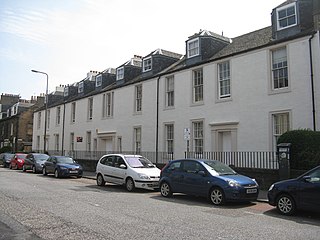
The Royal Highland Fusiliers, 2nd Battalion, Royal Regiment of Scotland is an infantry battalion of the Royal Regiment of Scotland.

The 32nd Signal Regiment is a British Army Reserve Regiment of the Royal Corps of Signals. The regiment forms part of 1st Signal Brigade, providing military communications for national operations.

44th Parachute Brigade was a British Army Territorial Army parachute brigade, active from c.1950 to 1978.

Gordon Barracks is a military installation situated in Bridge of Don, Aberdeen.
The 157th Brigade was an infantry brigade of the British Army. The brigade fought in both the First and the Second World Wars, assigned to 52nd (Lowland) Infantry Division.
The Northern Army Group (NORTHAG) was a NATO military formation comprising five Army Corps from five NATO member nations. During the Cold War NORTHAG was NATO's forward defence in the Northern half of the Federal Republic of Germany (FRG). The Southern half of the Federal Republic of Germany was to be defended by the four Army Corps of NATO's Central Army Group (CENTAG). During wartime NORTHAG would command four frontline corps and one reserve corps. Air support was provided by Second Allied Tactical Air Force.

The page contains the current structure of the British Army. The British Army is currently being reorganised to the Future Soldier structure.

The Gilmore Place drill hall was a military installation in Edinburgh.
The following is a hierarchical outline for the structure of the British Army in 1989. The most authoritative source for this type of information available is Ministry of Defence, Master Order of Battle, and United Kingdom Land Forces, HQ UKLF, UKLF ORBAT Review Action Plan, HQ UKLF, 1990.
201 (Northern) Field Hospital was a unit of the Royal Army Medical Corps within the Army Reserve of the British Army.
202 (Midlands) Multi-Role Medical Regiment is a unit of the Royal Army Medical Corps within the Army Reserve of the British Army.

203 (Welsh) Multi-Role Medical Regiment is a unit of the Royal Army Medical Corps within the Army Reserve of the British Army, based in Wales.

204 Field Hospital was a unit of the Royal Army Medical Corps within the Army Reserve of the British Army.
207 (Manchester) Field Hospital was a unit of the Royal Army Medical Corps within the Army Reserve of the British Army.
208 (Liverpool) Field Hospital was a unit of the Royal Army Medical Corps within the Army Reserve of the British Army.
212 (Yorkshire) Field Hospital was a unit of the Royal Army Medical Corps within the Army Reserve of the British Army.
243rd (Wessex) Multi-Role Medical Regiment is a unit of the Royal Army Medical Corps within the Army Reserve of the British Army.
256 Multi-Role Medical Regiment is a unit of the Royal Army Medical Corps within the Army Reserve of the British Army.

The 211 (Wessex) Field Hospital was a field hospital of the British Army forming part of the Royal Army Medical Corps. Formed in 1967 and disbanded in 1996, the hospital's remaining detachments continue to serve in its successor unit, the 243 Field Hospital.
The 219th (Wessex) Field Hospital was a field hospital of the British Army forming part of the Royal Army Medical Corps. Though short-lived having been formed in 1967 and disbanded in 1996, the hospital's remaining detachments continue to serve in its successor unit, the 243rd Field Hospital.







